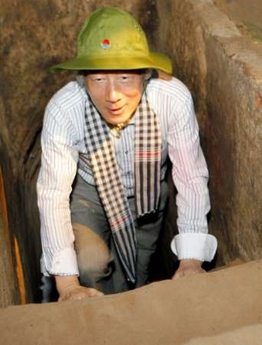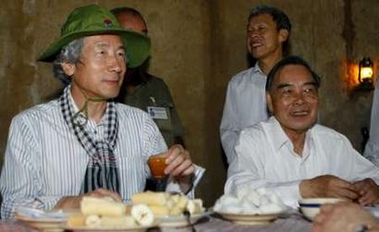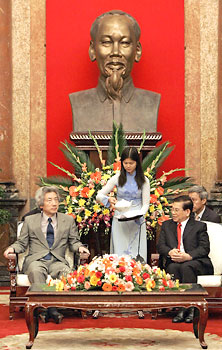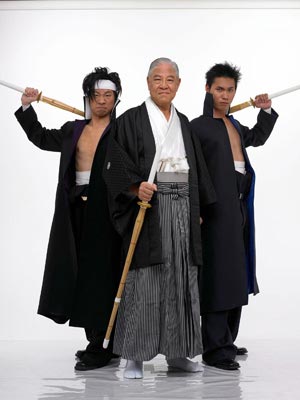Several weeks ago I wrote a brief post about how the famous destruction of Korea Air Lines flight 007 by the Soviets led rather directly to the development of commercial GPS technology. I just happened across another surprising result of the same incident, in this Vanity Fair article on, of all people, Larry Flynt.
In 1976, Mr. Flynt, publisher of Hustler and several other pornographic magazines, put out a $1 million bounty for “documentary evidence of illicit sexual relations with a Congressman, Senator or other prominent officeholder.” As the article says, “A few years later, Flynt published pictures of Representative Larry McDonald, a Georgia Republican, in bed with a mistress,” but Rep. McDonald was on the ill-fated KAL007 when it was shot down by the Soviets.
Naturally, the presence of Congressman Larry McDonald on a jet which was shot out of the sky by the USSR was taken by some to be more than a coincidence. While McDonald was, and still is, the only member of Congress killed by the Soviets, there were in fact three other Congresspersons schedule to fly along-side him on KAL007; Republicans Jesse Helms, Senator of North Carolina and Steve Symms, Senator of Idaho and Congressman Carroll Hubbard, a Democrat of Kentucky. All four-McDonald and the three who whose flights were rescheduled-were known for their strident anti-Soviet views, and there were naturally conspiratorial accusations made against the USSR. For example, Wikipedia cites the following quotation of the (despicable) Reverend Jerry Falwell from the September 2, 1983 Washington Post:
There is a real question in my mind that the Soviets may have actually murdered 269 passengers and crew on the Korean Air Lines Flight 007 in order to kill Larry McDonald
Natural responses to this may include the thought that the assassination of either one or four members of the US Congress by the Soviet Union might provoke a rather harsh reaction, or perhaps the thought that there was in fact nothing to gain from the murder of these four relatively minor congresspersons- McDonald was himself not known for legislative accomplishment, and although Jesse Helms might have been a tempting target when he was head of the Senate Foreign Relations Committee, he did not ascend to that post until a decade later, in 1993.
McDonald was himself a well-known conspiracy theorist, who had made the following statement:
The drive of the Rockefellers and their allies is to create a one-world government combining supercapitalism and communism under the same tent, all under their control…Do I mean conspiracy? Yes I do. I am convinced there is such a plot, international in scope, generations old in planning, and incredibly evil in intent.
While more rational thinkers may question the wisdom of this statement, and perhaps of the voters who elected a paranoiac to Congress, it does seem likely that Representative McDonald would have agreed with the Reverend Falwell about the circumstances surrounding his own death.
For the truly sophisticated conspiracy buff, however, we have a more complex, and utterly contradictory theory, brought to us by-of all places- Hustler Magazine. Now, while Playboy is well known for its mix of dull soft-core pornography and oddly serious articles, I had no idea that Hustler printed in-depth political conspiracy articles (much less articles at all) mixed with its rather harder-core pornography. However, if this piece is indicative of the quality of Hustler’s political “reporting” I think I’ll stick with publications more along the lines of The Economist for my real news- although, a paranoid and elaborate conspiracy theory can provide some entertaining flavor to more staid coverage. I will not try and summarize this inane theory, which involves such things as a “$100,000 computer” full of illegal spying data-in a garage, the Moonies, and Reagan’s decision to make a martyr of “the leading anti-Communist in the American government,” I will provide what I thought were a few of the highlights.
- “So let’s assume that the CIA, FBI and all federal agencies that worked with McDonald – particularly the Pentagon – wanted him silenced immediately.”
- “A more likely possibility is that the crew had been the victim of hypnosis and mind control – receiving instructions in advance, before they left Anchorage, that could not be picked up on any messages recorded later.”
- “His response to what was going to happen, given his years of experience and expertise, was that of a programmed zombie instructed to fly continuously – disregarding any external sights or sounds on the flight equipment.:
- “The upshot of these reports is that the Pentagon had the capability, if it so desired, to link mind control with satellite defense systems. And a logical use of mind control, of course, would be to program a pilot – perhaps even turning a normal flight into a kamikaze mission.”
- “After McCarthy died in 1957, it is reasonable to assume that Larry McDonaid – through Louise Bees – took over the massive computerized files [known as Odessa, which was formed (by the Nazis) between 1943 and 1945 when it became obvious the Third Reich could not win the war against the Soviet Union]that now contain millions of names worldwide.”
As implausible as all of this is, the fact most destructive to the theory that President Reagan ordered the plane led off-course into Soviet airspace so that the plane would be shot down, killing Congressman Larry McDonald, is perhaps Reagan’s action described in my previous post on KAL007: namely the opening of the formerly military-exclusive GPS network to civilian use. While I might not put it past the Reagan administration to commit assassination, if murder-by-Soviet-airspace-intrusion-disguised-as-navigation-error was such an effective and untraceable method of assassination, why then immediately turn around and introduce protocols that would make further use of the tactic implausible? Naturally, the conspiracy fan will turn around and say “that’s just what they want you to think; it’s the ultimate cover-up!” But credulity has its limits, and Occam’s Razor is powerful.
McDonald may have had a powerful hate for the USSR, but he was certainly was not important enough to deserve such elaborate machinations, the blood-enmity of a Soviet Premiere or an American President, and secret mind control rays from space itself. Like the other 268 passengers on KAL007, he was simply a victim of bad luck and incompetence, like so many others.
And this brings us to the heart, the essential nature of what conspiracy theories are all about: a fear of powerlessness. There is a common misconception that the conspiracy theorist is a cynic of the highest order, but in fact nothing could be further from the truth. The conspiracy theorist is actually a romantic. Unable to accept the reality of a chaotic universe in which all of us humans come from dust only to return to dust, the conspiracy theorist, somewhat like the believer in divine preordination, requires a conscious actor in all things to explain the misery in the world, and to alleviate the crushing fear of oblivion and hopelessness that lies within themselves.
Perhaps the most popular subject for conspiracy theorization in our time is the coordinated hijacking/kamikaze attacks of September 11, 2001. Details vary, including theories that the Pentagon was hit not by a jet but by a military cruise missile, or that the Twin Towers were felled not by steel girders whose tensile strength could not hold up to burning jet fuel but by a controlled demolition triggered by the CIA at the instant of airplane impact, or that the the hijackers were not in fact Islamic fanatics belonging to a shadowy terrorist network with a history of rhetorical and physical attacks against the United States, but Israeli Mossad agents, working in concert with the highest levels of US intelligence. The exact details are not really important, because all of these conspiracies share a common theme and a common purpose. The common theme is the attribution of enormous, almost supernatural, levels of power to the United States and other well understood state actors such as Israel, combined with the discrediting of obscure and occult non-state actors such as Al-Qaeda. The purpose is the reinforcement of their conventional world view to the extent that they can maximize a feeling of safety.
This may seem counterintuitive to some, but I believe that there is a misconception regarding what exactly conspiracy theorists are scared of. One might logically think that bu attributing such nefarious intent and grand power to our government, their primary fear is in fact the government. I would argue that the opposite is true. It is apparent to anyone that a world in which planes are shot out of the sky or crashed into buildings is more dangerous than one in which they do not, but anyone with even the most tenuous grasp on reality will accept that we live in a world in which these things happen; the distinction is over why, and how. If a world of death and pain is taken as a given, then how is fear of that minimized? By reducing the randomness and chaos with which that death is meted out. Conspiracy theorists ascribe nigh-omnipotence to the government not because they are so scared of the government but because they are far more terrified of the alternative- that terrorism, assassination, airplane failure, and so on, are the products of forces unpredictable and uncontrollable.
To a conspiracy theorist there is always a larger cause. Take the assassinations of Presidents Abraham Lincoln and John F. Kennedy, each of which was the premiere subject of conspiracy theorizing for many years, and remain popular subjects to this day. In both cases the official, and most widely accepted, version of the story is that a lone troubled soul, albeit one whose sympathies were shared by many others, shot and killed the President of the United States, the most powerful man in what was, at least during the time of JFK, the most powerful country in the world. If such random tragedy could strike such a man, how can any of us possibly feel safe? In a world in which even presidents are murdered and airplanes are crashed into buildings or explode in the sky due to fuel tank errors (the TWA 800 tragedy, which has its own crop of conspiracy theories) how can any of us feel safe on an airplane, or going to the theatre, or simply riding their car down an open street?
There are a few alternatives. For most people the answer is simply to be realistic; while tragedy can be random, it is also rare and a life lived in perpetual terror is a poor life indeed. Others do live in fear, barely functioning, and living a terrible agoraphobic life of isolation. And others find solace in a false order, of complex constructed narratives in which they either assign enormous power to the relatively powerless actor behind such tragedies, or assign an entirely imaginary actor in cases that truly were due to chance or sloppiness. It is easier to sleep at night when you believe that JFK was killed as a result of a vast and shadowy conspiracy, because by extension that is what it would take. If tragedy requires such incredible effort and resources, then we are all relatively safer, because who would bother with us? By arguing with such venom for the existence of a reality in which all of the world’s random accidents and low-tech terrorism are in fact the result of elaborate conspiracies conducted by the ostensibly powerful, conspiracy theorists are actually choosing order over chaos: a world in which they can sleep at night, because the knife in the shadow never misses its intended target.






